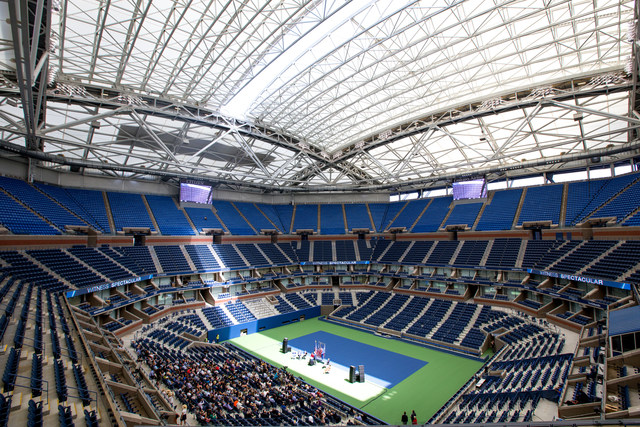US Open Audio Takes ‘Nat Sound’ to Its Logical Conclusion
Story Highlights
In getting a retractable roof, Arthur Ashe Stadium at the Billie Jean King National Tennis Center in Queens, NY, traded one issue bedeviling tennis for another: instead of getting wet when it rains, the venue has gotten louder, thanks to the natural amplification and reverberation of fan chatter, particularly from seats in the upper stands that are closest to the roof.
When rain fell as the US Open began last week, the New York Times jumped on the story, reporting that “the solution to one problem has made another one more acute.” But don’t tell that to the folks who get that sound onto the airwaves.
“It’s a naturally occurring phenomenon,” says ESPN Audio Supervisor Florian Brown. “We’re here to document what happens at the US Open. Everything, including that.”

When fully closed, the new roof on Arthur Ashe Stadium functions like a parab mic, capturing fan noise.
He describes the new roof, when fully deployed, as a giant parabolic reflector, similar in effect to the parab mics that roam the sidelines of many outdoor sports broadcasts. The noise heard by fans in the stadium and those at home comes from the same source it always has: chattering tennis aficionados, with the usual inverse ratio between the cost and height of the seat and the volume level produced. But because of the acoustic nature of the new roof, those murmurs have become a persistent, low-level roar, live and on-air.
There are no nifty microphone techniques or processing tricks that can eliminate the noise, even if that were necessary, which it isn’t, Brown says. “Noise has always been part of tennis here,” he explains, noting the proximity of the elevated subway (the notorious 7 train, famously reviled by Atlanta Braves pitcher John Rocker for other reasons) and the steady stream of departures from nearby La Guardia Airport (which the USTA was once able to persuade the Port Authority to reroute during the Open), as well as just baseline New York noise.
“The sound is there,” he says, “and it needs to be part of the sound of the game. One of the other reasons it’s so noticeable is that the ball frequencies and the frequencies of the noise are so different; they really stand out.”
Brown, fellow audio supervisor Leonard Fisher, and effects mixers Tim Bishof and Peter Puglisi do have a few technical tricks that can work to reduce the presence of unwanted sound. They are running a CEDAR DNS 8 dynamic noise-suppression system in line to the Lawo MC56 audio console, provided by equipment supplier Gearhouse Broadcast, housed in a two-story structure that sits behind Arthur Ashe Stadium. The system samples and analyzes the entire sonic spectrum in the venue and indicates problem areas, which the engineers can attenuate or not as the situation warrants. But its effects are more nuanced than noticeable. Most of the noise is still there, because it’s simply part of the tennis soundscape in New York and part of the sport’s less dainty side, one where the grunts of players prompted an official crackdown by the sport’s governing body in 2012.
Brown believes that that effort has seemed to work, with less obvious grunting emanating from the courts. But such an initiative would likely have less salubrious results if applied to the fans in the stands. It is New York City, after all.
